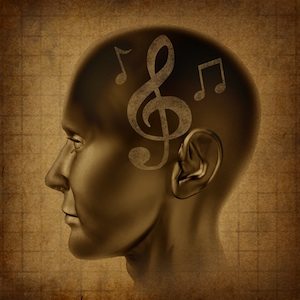Wish you could transcribe that crazy guitar lick?
Or spout out pages of music like a modern day Mozart?
Learn how to transcribe music and develop your mind’s ear through ear training and audiation.
Don’t know how? Easy Ear Training will get you started!
The Mind’s Ear
If you are like any musician or music lover, music plays in your head throughout the day, from your favorite pop tune to some annoying jingle reminding you to buy toothpaste. Sometimes you hear a crazy-awesome drum lick or bass riff and wish that you could transcribe the music – right now! You can learn how to transcribe music in minutes, but you first have to learn how to really listen to the music playing in your head.
Audiation
You can develop your mind’s ear through singing what you hear in your head, commonly called ‘audiation’.
Take a moment and think about your favorite Top 40 tune. Now sing the song out loud.
Being able to “play back” the melodies, pitch, rhythms, and timbre that you hear in your head like this involves audiation[1]. Believe it or not, singing your favorite songs out loud (without the radio playing) helps you develop your mind’s ear. Now you have a good excuse for singing in the shower!
Next time you want to learn a tricky instrumental lick or drum solo, follow these simple steps:
- Play the music back, over and over silently, as if your mind’s ear is an iPod.
- When you think you have it clear in your head, sing the notes or rhythm aloud.
- Once you have mastered this, then go to your instrument.
- Sing and play the part simultaneously.
Apply this singing ear training process to every time you want to learn new music. You will find that the process becomes easier as you practice using ear training and audiation to learn new music. Eventually you can apply this simple process to music transcription too. For some more tips on transcription, check out Matthew Abdallah’s article on tips and tricks for transcribing songs.
More resources for developing your mind’s ear
Here are some helpful music resources for learning how to develop your aural skills using audiation:
1. Playing “Am I Musical?” Music Audiation Games
Created by music researcher Edwin E. Gordon, “Am I Musical” provides a variety of multilevel ear training exercises with select audio samples.[2]
2. The Suzuki Method

Engage your children in the Suzuki method of learning: a highly successful Japanese teaching method that combines developing the mind’s ear and string instrument performance. Ear training is an essential component of the Suzuki Method. Find out more about Suzuki and ear training.
3. Deep Listening
Try Deep Listening exercises in your daily life. Legendary composer Pauline Oliveros developed Deep Listening as a way to develop the mind’s ear. Read more about Deep Listening and ear training.
4. Step and a Half
Easy Ear Training provides our own specialised mobile apps to develop your mind’s ear ‘on the go’: like Step and a Half, a great game that will get you a step closer to music transcription by helping you recognize music intervals in the context of a tune.
Practice audiation and deep listening to develop your mind’s ear. What ear training tricks do you use when you learn new music? Do you have any music transcription tips to share? We’d love to hear from you in the comments below.
Show article sources
Sources
- Garner, A. (2009). Singing and Moving: Teaching Strategies for Audiation in Children. Music Educators Journal, 95(4), 46-50.
- Gordon, E. (2003). Am I Musical? Music Audiation Games.







